Art World
Discovering Perugino
The "Divine Painter" had monumental impact on the development of the Renaissance.
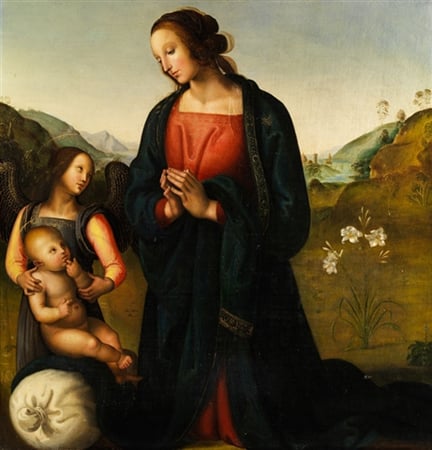
The "Divine Painter" had monumental impact on the development of the Renaissance.

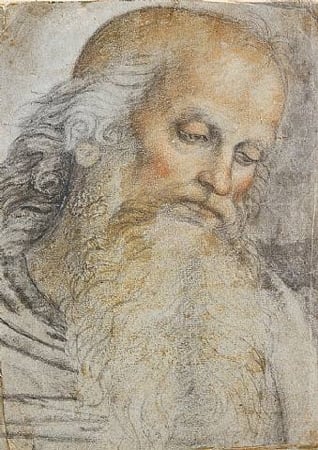
Perugino, Kopf Johannes des Täufers / The Head of St. James
After moving to Perugia, Italy, nearly 10 years ago, I learned about the local legend, Perugino (Italian, circa 1450—1523), by visiting one of his masterpieces, the Collegio del Cambio. Something there stuck with me, and in every museum I went to afterwards, whether it be in Rome, Paris, London, or Detroit, when I saw a work by Perugino, it was like seeing an old friend. Now that I’m living and working in New York, I continue to keep an eye out for the artist, and am happy to discover many traces of him at auction.
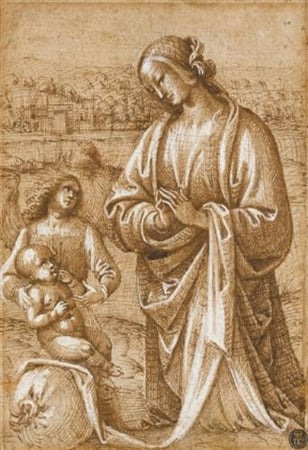
Follower of Perugino, The Madonna kneeling before the Christ Child, who is seated on a sack and supported by an angel
Perugino had a monumental impact on the development of the Renaissance. His contemporaries called him a Divine Painter, and Raphael’s father called Perugino and Leonardo da Vinci the masters of the age. The artist obtained commissions from the most elite patrons of the day, including several popes, the doge in Venice, Lorenzo de’ Medici, Ludovico Sforza, and Isabella d’Este. Today, Perugino is famously recognized as the teacher of Raphael; however, his legacy is certainly not limited to this achievement alone. Despite his incredible success, Perugino is often brushed past today, but I believe he deserves more attention.

After Perugino, La Madonna del Sacco
Pietro Vannucci, later to be known as Perugino, was born in a small town called Città della Pieve, located near Perugia, Italy, around 1450. It is surmised that at a young age he went to study in Perugia, the cultural capital of the region. After this initial training, he went to Florence to study alongside Leonardo da Vinci in the workshop of Andrea del Verrocchio. Within a few years, Perugino acquired several important commissions in Perugia, followed by some work for the Pope in Old Saint Peter’s in Rome. These works must have been impressive, because he was soon called back to lead a group of top artists in decorating the walls of the Sistine Chapel. From that moment on, Perugino’s career was a brilliant success; he used a style that appealed to both the wealthiest, most decadent patrons and the most pious clergy. He set up workshops in both Florence and Perugia, and traveled all over Italy, taking on a vast number of commissions. Around 1500, Perugino was at the peak of his success, having completed an astonishing fresco cycle in the Collegio del Cambio in Perugia (most likely with the help of his apprentice, the young Raphael). He was simultaneously completing many important altarpieces, portraits, and private devotional images. It was during this time that the popularity of his style permeated artistic taste, especially in the region of Umbria.
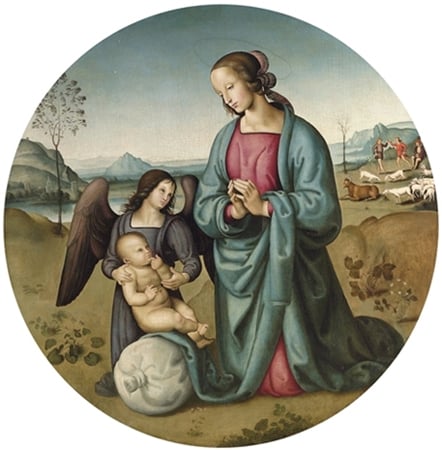
Circle of Perugino, The Madonna and Child with an angel in a landscape
While living in Perugia, I drove throughout the hilly region, visiting remote chapels and palaces filled with frescoes and altarpieces, where Peruginesque figures immediately jumped out at me. The artist’s style was emulated to such a high degree that I wondered how it was possible that all my art history courses of the past had simply jumped over him. Perugino continued to provide inspiration to other Umbrian artists, as evidenced by the work of subsequent masters in and around Perugia for decades to come. One theme that was particularly successful for Perugino was that of the Madonna and Child. Small, devotional images (as opposed to large altarpieces) of the Madonna and Child were made for private worship. He placed his subjects in front of an idyllic landscape of greens receding into misty, atmospheric blue, a setting not too different from the view still seen from Perugia. The viewer is not distracted by superfluous ornamentation, and is instead transfixed by the purity of the subject.
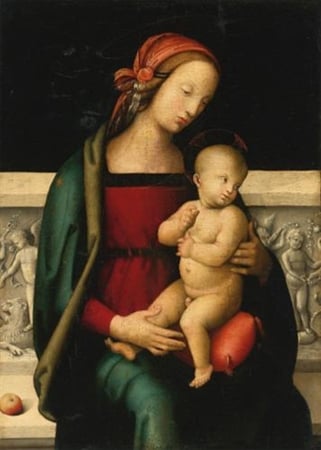
Circle of Perugino, The Madonna and Child seated before a sculpted parapet, an apple resting beside her
Perugino’s subjects never overtly recall the physical traits of a particular person; they feature a classic harmony and beauty. This trademark of Perugino’s style relies on the suggestions mapped out by Leon Battista Alberti in his On Painting:
“… he should be attentive not only to the likeness of things but also and especially to beauty, for in painting beauty is as pleasing as it is necessary. The early painter Demetrius failed to obtain the highest praise because he was more devoted to representing the likeness of things than to beauty. Therefore, excellent parts should all be selected from the most beautiful bodies, and every effort should be made to perceive, understand and express beauty. Although this is the most difficult thing of all, because the merits of beauty are not all to be found in one place but are dispersed here and there in many, every endeavor should none the less be made to investigate and understand it thoroughly1.”
This ideal beauty is coupled with traditional medieval representations of divinity in Perugino’s work. In the middle ages, and continuing into the early Renaissance, artists adhered to the traditional iconography of the Madonna, which depicted the figure as dressed in red with a blue cloak decorated with a star. Following this tradition, Perugino painted an instantly recognizable Madonna united with contemporary ideal beauty. He notoriously repeated these same types of idealized figures in his work; he chose to do so not out of ease and the reuse of cartoons, but because society called for a specific quality of images to be used in worship.
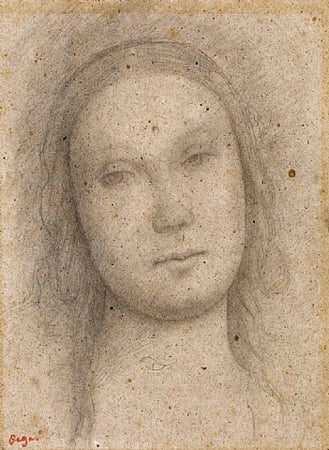
Edgar Degas, The Head of a Young Woman, after Perugino
Madonna and Child paintings dating from the height of Perugino’s success can be found in museum and private collections around the world, a few of which have entered American collections, including a Madonna and Child piece at the Detroit Institute of Art, one in the Samuel H. Kress Collection, and another at the Morgan Library. These exquisite works are examples of compositions that were copied by contemporaries and future admirers of Perugino. In a Renaissance workshop, pupils were taught to mimic the style of their master. Perugino was incredibly effective in this method of teaching.
Another type of Madonna and Child image that was greatly admired is that of the Madonna del Sacco (Madonna with the Sack), similar to the Perugino work in the Morgan Library. This variation shows the Madonna kneeling next to a Christ child propped up on a pillow, or a sack. She is sometimes joined by an angel, an infant John the Baptist, or other saints. This composition was used for an important altarpiece commissioned by the Duke of Milan, and for the Nativity fresco in the Collegio del Cambio. In addition, Perugino repeated this imagery in a much-admired work, which can be found today in the Galleria Palatina in Florence. I have noticed that copies of this popular Madonna del Sacco composition frequently arise at auction.
As the leading artist of his day, it comes as no surprise that many artists imitated Perugino’s style in their own quest for success. Evidence of this is not only found in museum collections or the rural churches I explored, but in treasures that surface in auction from time to time, a thrilling testament to Perugino’s glory and talent. I was delighted to discover that two recent Sotheby’s Auctions in New York, which took place from January 29 through 30, included both a Madonna and Child painting from the circle of Perugino as well as a Madonna del Sacco drawing by a follower of Perugino.
1 Leon Battista Alberti, On Painting (London: Penguin Books, 2004), 90.